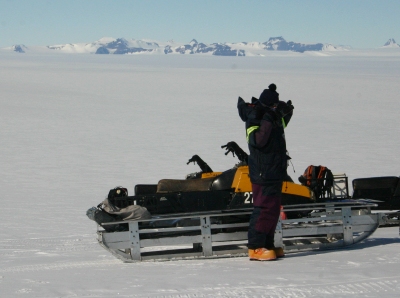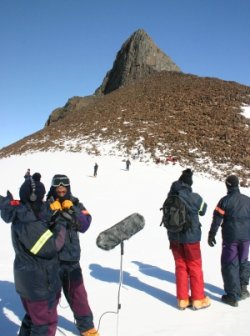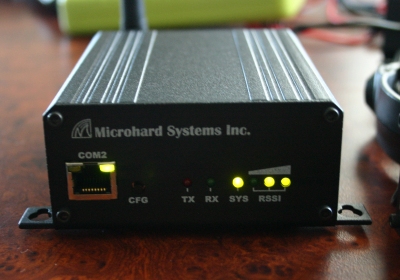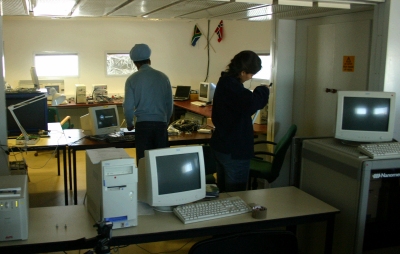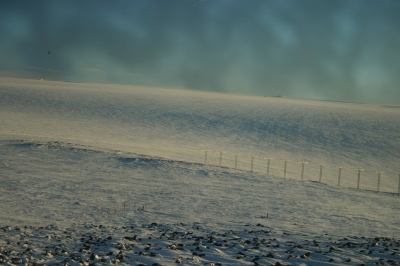I-TASC expedition 2006/2007
Happy New Years Day. Last night we had a party for New Years with everyone having a boogie and some had lots to drink while others took it easy. I took the later strategy and I am thankful not to have a hangover. It was a great party though and everyone had a great time. The PWD guys (they do the maintenance for the base) dressed up as if it was Carnival and did a street boogie with ringleader and limbo and were generally the life of the party.
Now there is a storm building up outside. The sky is as white as the land so all you can see are floating rocks which make up the Nunutaks. If you look at the rocks around the base, there is a wind-strewn fog running along the ground. It will probably be a small storm, running just for a day or two, with relatively low winds. Even so, as I look out the window now, this is what I would call a windy day in Wellington – the fog is moving at quite a pace and I can easily hear the sound of the wind from inside the noisy lab (and this is just the preliminary build up to the storm). I asked one of the experienced SANAE crew to check the antenna and apparently we mounted it fine. In the winter, apparently, the whole base shakes to the storms. One of the over-wintering crew said that you can feel like you are in a boat in a swell. I don’t know if the pictures so far have given you an idea of the scale of the base, but suffice to say that it is massive and it’s difficult to believe this base would move at all. So the storms must be amazing. At times the crew felt the base was going over the hill, they always knew it would be OJ but the shaking was so fierce it freaked them out anyway. I also heard a story from Tom about one of the crews that helped build the base. They stayed in a container bolted to the rock and they had one storm where they knew the container was going to be blown away. Thankfully it didn’t happen.
We had an interesting discussion yesterday about the Automatic Weather Station (AWS) and art. Part of the installation is sculptural, it is a functioning AWS, but also deliberately a monolith. I had not previously understood that the AWS had this artistic sculptural component and I felt very uneasy about it, especially since the casing is larger (quite a bit larger) than necessary to fulfill its desired aesthetic.
For me, this is quite close to the heart of my questioning the role of art/culture here and our presence in Antarctica. It was a great discussion, and I especially appreciated some of Amanda’s comments. I will have to think about it more. There is a balance to be met somewhere, if there is to be a cultural presence here, then it must draw its own lines as to what is acceptable. Art in itself is not a justification for just doing anything that an artist desires. The base has a quite strict environmental policy and the Antarctic Treaty is also quite strict (I haven’t read it, I am taking this information from discussions with Tom who has read it). If anything is to be installed, it needs to have an Environmental Impact Assessment (EIA). The AWS will probably pass this threshold (the Environmental Officer arrives on the 11th of Jan to do this and other evaluations). However, even if it does pass, I am not sure if I enjoy the idea of an overly large object being in the space if the justification is that it is sculptural. It’s a difficult question, as I understand the artistic motivations of the AWS project and I think it is good art, but is that enough?
I also enjoyed some of the points made about the fact that we live in this world and people should come to Antarctica, and culture has a place here etc. It was a position that was touted as being more realistic than my suggested idealism. I’m not sure I am an idealist. I am just a bit depressed about the damage that we have already done to the planet, but I take their points. Perhaps there could be a role for artists here, but that is ‘perhaps’ with a capital ‘P’. If this were to be the case, I think there need to be some lines drawn. One of the advantages of having SANAE governed by the government is that most governments are slow moving and conservative (I never thought I would see the day I thought that an advantage!). This brings quite a strict and procedural process to the activities here, which minimises the environmental impact. Everything done has to be evaluated, checked, and then checked again. Activities that are too dangerous or which do not conform to the environmental policies cannot take place. Having said that, there is, of course, inevitable leakage and some pragmatic bending of rules. It would be good for any group (such as I-TASC) to consider where their own lines are, and how these would be maintained. I don’t think artists should be given free reign to do as they wish, the environment here is just too important for that…
As for my own work, I am still working through my own position in this with regard to the work I am doing here. In the meantime, I am getting on with the chores at hand. This at times makes me feel like quite a hypocrite when I am exploring a line of thought which is sometimes against us being here. I have to acknowledge to myself that my thoughts are evolving daily and I feel I have not yet reached my final point on these issues. So I continue to work on the tasks required. It is difficult to do this at times and feel good about what I am doing, but I must give myself some time to reflect on all this and assist my colleagues at the same time. Yesterday, I did some work on the radio terminal, making some new serial cables to try and crack the mystery of why it’s not working. So far, nada. I should have gone and had more of a party instead but at least we have eliminated some possibilities. I think now I am going to write up everything I have tried, and Marko (in Slovenia) said he would contact the manufacturers and ask for their advice. They don’t get back from holidays until the 5th so in the meantime I will set up the radio station with First so it gets into a more regular schedule. Below is an announcement my colleague Honor (r a d i o q u a l i a) sent out yesterday.
In addition to this call,if anyone can send a full set of Debian CDs (Debian Testing) to the below address, that would be fantastic. We need it for the station and also there is one of the crew that has just done one full year here and will do his second full year to replace our colleague that was killed. He would very much appreciate these CDs as the ones he had sent with the boat are corrupted.
r a d i o q u a l i a call for content
r a d i o q u a l i a have just begun broadcasting a new FM radio station in Antarctica. 'Polar Radio' is Antarctica's first ever artist-run radio station. It transmitted its first programme on FM on 29 December 2006. Polar Radio is part of a series of projects run by I-TASC - the Interpolar Transnational Art Science Constellation Please see the below announcement for more information about Polar Radio. CALL FOR CONTENT - DEADLINE: 10 JANUARY 2007 Do you have a song, a message, or a sound that you want broadcast in Antarctica? We are looking for your music, sound art, radio plays, radio documentaries, and any phonically interesting artifacts you have to broadcast on Antarctica first artist-run radio station. There is a supply plane leaving for Antarctica from Cape Town on 11 January. We plan to have a shipment of CDs sent on that supply plane. We are now looking for CDs of: - music of all different kinds - radio art - radio plays - audio documentaries - audio books - archived news reports - investigative journalism - podcasts - any other audio material you would like to have broadcast in Antarctica If you have sonic material you want broadcast, please make a CD and send it to: Siphiwe Ngwenya / I-TASC c/- Pitch Black Productions 7 Prince Street Gardens Cape Town 8001 South Africa The best formats to send are: - audio CDs - MP3 CDs
So send what you can 🙂
